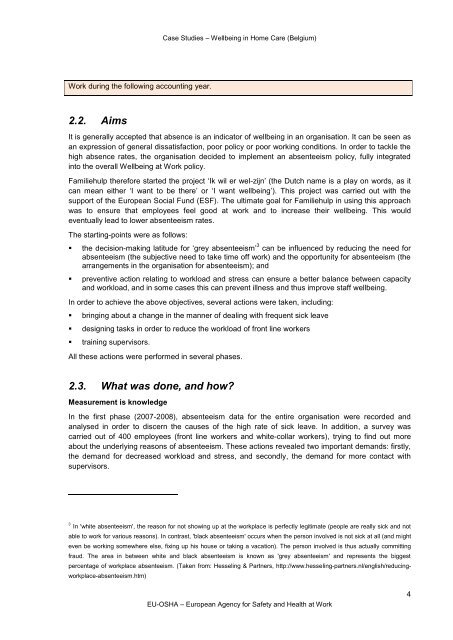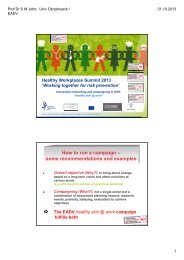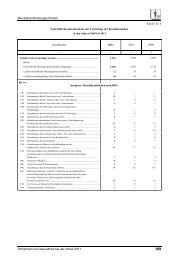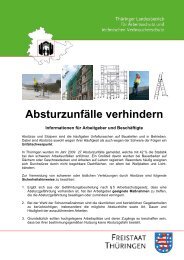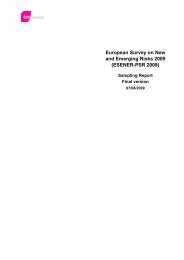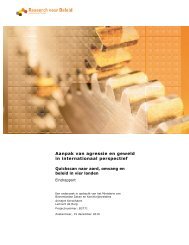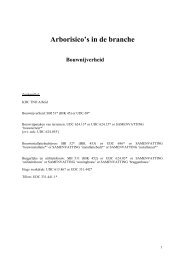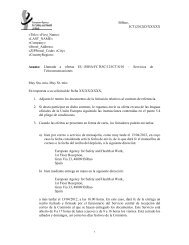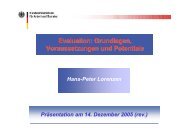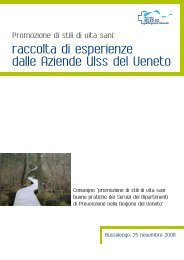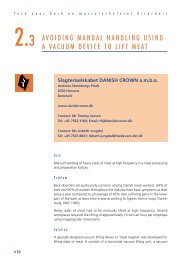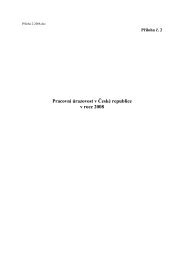Familiehulp - European Agency for Safety and Health at Work
Familiehulp - European Agency for Safety and Health at Work
Familiehulp - European Agency for Safety and Health at Work
Create successful ePaper yourself
Turn your PDF publications into a flip-book with our unique Google optimized e-Paper software.
<strong>Work</strong> during the following accounting year.<br />
2.2. Aims<br />
Case Studies – Wellbeing in Home Care (Belgium)<br />
It is generally accepted th<strong>at</strong> absence is an indic<strong>at</strong>or of wellbeing in an organis<strong>at</strong>ion. It can be seen as<br />
an expression of general diss<strong>at</strong>isfaction, poor policy or poor working conditions. In order to tackle the<br />
high absence r<strong>at</strong>es, the organis<strong>at</strong>ion decided to implement an absenteeism policy, fully integr<strong>at</strong>ed<br />
into the overall Wellbeing <strong>at</strong> <strong>Work</strong> policy.<br />
<strong>Familiehulp</strong> there<strong>for</strong>e started the project ‘Ik wil er wel-zijn’ (the Dutch name is a play on words, as it<br />
can mean either ‘I want to be there’ or ‘I want wellbeing’). This project was carried out with the<br />
support of the <strong>European</strong> Social Fund (ESF). The ultim<strong>at</strong>e goal <strong>for</strong> <strong>Familiehulp</strong> in using this approach<br />
was to ensure th<strong>at</strong> employees feel good <strong>at</strong> work <strong>and</strong> to increase their wellbeing. This would<br />
eventually lead to lower absenteeism r<strong>at</strong>es.<br />
The starting-points were as follows:<br />
the decision-making l<strong>at</strong>itude <strong>for</strong> ‘grey absenteeism’ 3 can be influenced by reducing the need <strong>for</strong><br />
absenteeism (the subjective need to take time off work) <strong>and</strong> the opportunity <strong>for</strong> absenteeism (the<br />
arrangements in the organis<strong>at</strong>ion <strong>for</strong> absenteeism); <strong>and</strong><br />
preventive action rel<strong>at</strong>ing to workload <strong>and</strong> stress can ensure a better balance between capacity<br />
<strong>and</strong> workload, <strong>and</strong> in some cases this can prevent illness <strong>and</strong> thus improve staff wellbeing.<br />
In order to achieve the above objectives, several actions were taken, including:<br />
bringing about a change in the manner of dealing with frequent sick leave<br />
designing tasks in order to reduce the workload of front line workers<br />
training supervisors.<br />
All these actions were per<strong>for</strong>med in several phases.<br />
2.3. Wh<strong>at</strong> was done, <strong>and</strong> how?<br />
Measurement is knowledge<br />
In the first phase (2007-2008), absenteeism d<strong>at</strong>a <strong>for</strong> the entire organis<strong>at</strong>ion were recorded <strong>and</strong><br />
analysed in order to discern the causes of the high r<strong>at</strong>e of sick leave. In addition, a survey was<br />
carried out of 400 employees (front line workers <strong>and</strong> white-collar workers), trying to find out more<br />
about the underlying reasons of absenteeism. These actions revealed two important dem<strong>and</strong>s: firstly,<br />
the dem<strong>and</strong> <strong>for</strong> decreased workload <strong>and</strong> stress, <strong>and</strong> secondly, the dem<strong>and</strong> <strong>for</strong> more contact with<br />
supervisors.<br />
3 In 'white absenteeism', the reason <strong>for</strong> not showing up <strong>at</strong> the workplace is perfectly legitim<strong>at</strong>e (people are really sick <strong>and</strong> not<br />
able to work <strong>for</strong> various reasons). In contrast, 'black absenteeism' occurs when the person involved is not sick <strong>at</strong> all (<strong>and</strong> might<br />
even be working somewhere else, fixing up his house or taking a vac<strong>at</strong>ion). The person involved is thus actually committing<br />
fraud. The area in between white <strong>and</strong> black absenteeism is known as 'grey absenteeism' <strong>and</strong> represents the biggest<br />
percentage of workplace absenteeism. (Taken from: Hesseling & Partners, http://www.hesseling-partners.nl/english/reducing-<br />
workplace-absenteeism.htm)<br />
EU-OSHA – <strong>European</strong> <strong>Agency</strong> <strong>for</strong> <strong>Safety</strong> <strong>and</strong> <strong>Health</strong> <strong>at</strong> <strong>Work</strong><br />
4


